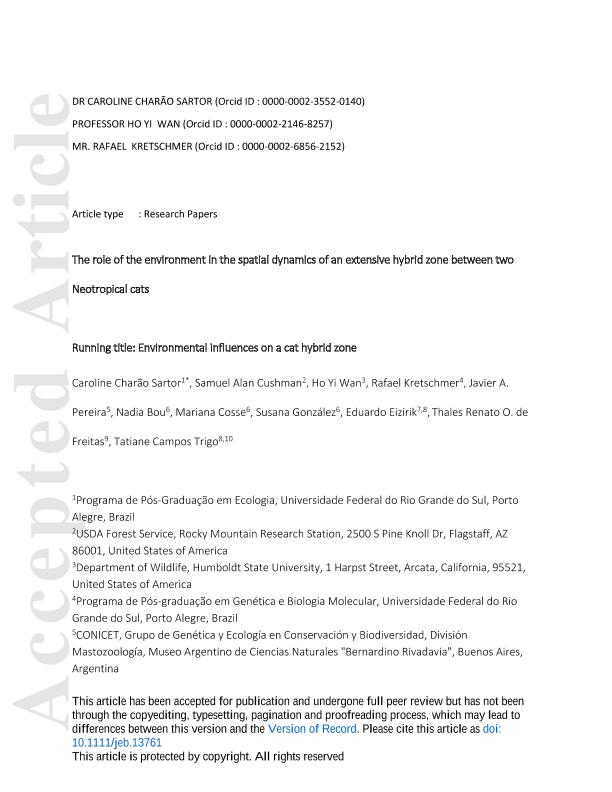Mostrar el registro sencillo del ítem
dc.contributor.author
Sartor, Caroline Charão
dc.contributor.author
Cushman, Samuel Alan
dc.contributor.author
Wan, Ho Yi
dc.contributor.author
Kretschmer, Rafael
dc.contributor.author
Pereira, Javier Adolfo

dc.contributor.author
Bou, Nadia
dc.contributor.author
Cosse, Mariana
dc.contributor.author
González, Susana
dc.contributor.author
Eizirik, Eduardo

dc.contributor.author
de Freitas, Thales Renato O.
dc.contributor.author
Campos Trigo, Tatiane
dc.date.available
2022-10-13T10:30:02Z
dc.date.issued
2021-04
dc.identifier.citation
Sartor, Caroline Charão; Cushman, Samuel Alan; Wan, Ho Yi; Kretschmer, Rafael; Pereira, Javier Adolfo; et al.; The role of the environment in the spatial dynamics of an extensive hybrid zone between two neotropical cats; Wiley Blackwell Publishing, Inc; Journal of Evolutionary Biology; 34; 4; 4-2021; 614-627
dc.identifier.issn
1010-061X
dc.identifier.uri
http://hdl.handle.net/11336/172836
dc.description.abstract
Identifying factors that create and maintain a hybrid zone is of great interest to ecology, evolution and, more recently, conservation biology. Here, we investigated the role of environmental features in shaping the spatial dynamics of a hybrid zone between the southern tigrina, Leopardus guttulus, and Geoffroy's cat, L. geoffroyi, testing for exogenous selection as the main force acting on its maintenance. These Neotropical felid species are mainly allopatric, with a restricted area of sympatry in the ecotone between the Atlantic Forest and Pampa biomes. As both biomes have experienced high rates of anthropogenic habitat alteration, we also analysed the influence of habitat conversion on the hybrid zone structure. To do this, we used 13 microsatellite loci to identify potential hybrids and generated ecological niche models for them and their parental species. We compared the influence of variables on parental species and hybrid occurrence and calculated the amount of niche overlap among them. Parental species showed different habitat requirements and predicted co-occurrence was restricted to the forest-grassland mosaic of the ecotone. However, hybrids were found beyond this area, mainly in the range of L. geoffroyi. Hybrids demonstrated higher tolerance to habitat alteration than parental types, with a probability of occurrence that was positively related with mosaics of cropland areas and remnants of natural vegetation. These results indicate that exogenous selection alone does not drive the dynamics of the hybrid zone, and that habitat conversion influences its structure, potentially favouring hybrids over parental species.
dc.format
application/pdf
dc.language.iso
eng
dc.publisher
Wiley Blackwell Publishing, Inc

dc.rights
info:eu-repo/semantics/openAccess
dc.rights.uri
https://creativecommons.org/licenses/by-nc-sa/2.5/ar/
dc.subject
ECOLOGICAL NICHE MODELLING
dc.subject
HABITAT CONVERSION
dc.subject
HYBRIDIZATION
dc.subject
LEOPARDUS GEOFFROYI
dc.subject
LEOPARDUS GUTTULUS
dc.subject
NICHE DIVERGENCE
dc.subject.classification
Ecología

dc.subject.classification
Ciencias Biológicas

dc.subject.classification
CIENCIAS NATURALES Y EXACTAS

dc.title
The role of the environment in the spatial dynamics of an extensive hybrid zone between two neotropical cats
dc.type
info:eu-repo/semantics/article
dc.type
info:ar-repo/semantics/artículo
dc.type
info:eu-repo/semantics/publishedVersion
dc.date.updated
2022-09-13T11:02:38Z
dc.journal.volume
34
dc.journal.number
4
dc.journal.pagination
614-627
dc.journal.pais
Reino Unido

dc.journal.ciudad
Londres
dc.description.fil
Fil: Sartor, Caroline Charão. Universidade Federal do Rio Grande do Sul; Brasil
dc.description.fil
Fil: Cushman, Samuel Alan. United States Department of Agriculture; Estados Unidos
dc.description.fil
Fil: Wan, Ho Yi. Humboldt State University; Estados Unidos
dc.description.fil
Fil: Kretschmer, Rafael. Universidade Federal do Rio Grande do Sul; Brasil
dc.description.fil
Fil: Pereira, Javier Adolfo. Consejo Nacional de Investigaciones Científicas y Técnicas. Oficina de Coordinación Administrativa Parque Centenario. Museo Argentino de Ciencias Naturales "Bernardino Rivadavia"; Argentina
dc.description.fil
Fil: Bou, Nadia. Ministerio de Educacion y Cultura.; Uruguay
dc.description.fil
Fil: Cosse, Mariana. Ministerio de Educacion y Cultura.; Uruguay
dc.description.fil
Fil: González, Susana. Ministerio de Educacion y Cultura.; Uruguay
dc.description.fil
Fil: Eizirik, Eduardo. Pontificia Universidade Católica do Rio Grande do Sul; Brasil
dc.description.fil
Fil: de Freitas, Thales Renato O.. Universidade Federal do Rio Grande do Sul; Brasil
dc.description.fil
Fil: Campos Trigo, Tatiane. Universidade Federal do Rio Grande do Sul; Brasil
dc.journal.title
Journal of Evolutionary Biology

dc.relation.alternativeid
info:eu-repo/semantics/altIdentifier/doi/http://dx.doi.org/10.1111/jeb.13761
dc.relation.alternativeid
info:eu-repo/semantics/altIdentifier/url/https://onlinelibrary.wiley.com/doi/10.1111/jeb.13761
Archivos asociados
